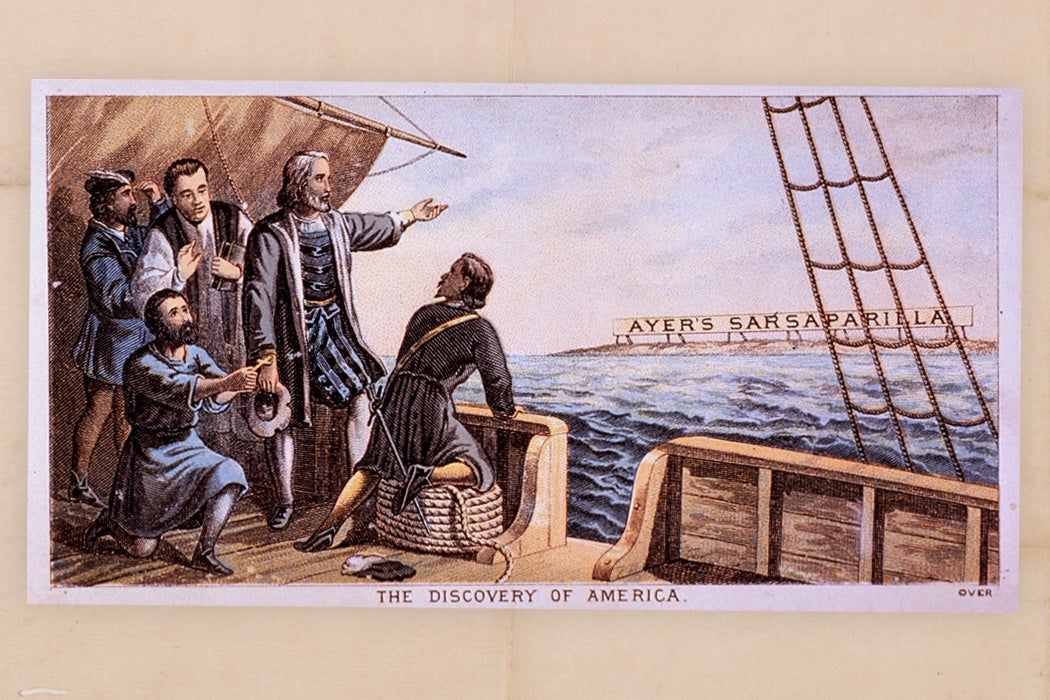Everyone who grew up with Saturday-morning cartoon television in the 1980s or 1990s is surely familiar with the universe of the Smurfs. During many years of adventures, however, the diet of the little blue creatures remained somewhat of a mystery. The principal ingredient of many of their dishes was “Smurf berries,” which grew on bushes, but the indistinct appearance of the bushes gave few clues about their botanical nature.
This was a deliberate move of the Smurfs’ creator, Belgian cartoonist Peyo (Pierre Culliford, 1928–1992). When the Smurfs were still only a European phenomenon, the Smurf berries were referred to by the French name salsepareille. Peyo chose this name for its exotic sound, initially being unaware that the name referred to very real plants. The name sarsaparilla or salsaparilla, as the plant is known in English, had been used for various species of the genus Smilax for centuries. When the Smurfs became a phenomenon in the United States, the sarsaparilla shrub lost its berries, because many American viewers were thought to be familiar with sarsaparilla as a real plant.
Smilax species are typically climbing vines (not Smurf shrubs) that can be woody, prickly, or both. They appear in tropical and subtropical areas around the world. The fact that an American audience might sooner recognize sarsaparilla than a European audience has everything to do with the plant’s history, which mainly revolves around Smilax species like S. aristolochiifolia and S. ornata, from Mexico and Central America. The best-known episodes from sarsaparilla’s history—first as a medicine and later as a tonic drink—are indeed about species from the New World.
The introduction of the Smurfs in the United States signified, in fact, sarsaparilla’s second Atlantic crossing. The oldest references to sarsaparilla are from Old World antiquity, where Smilax aspera was used as an antidote for poisons. The Roman medical writer Dioscorides (first century CE) devoted a chapter to this plant in his work about medicinal plants from the Mediterranean (De materia medica, book IV, chapter 142). He described the leaves and red berries as both a preservative and an antidote for poisons.
This description survived many centuries and became firmly embedded in the European medical tradition. Smilax aspera, which was the common Latin name for this plant long before Linnaeus classified it as an official binomial species name in the eighteenth century, became an antidote that could be recognized along the lines of the “doctrine of signatures.” According to this European ethnopharmaceutical tradition, diseases and their corresponding remedies co-occurred in the same places, in a balance ordained by God Himself. Humans could recognize the right medicinal plant for an illness by the “signs” it gave. The thorns of Smilax aspera were understood to resemble snake teeth, thus pointing to the plant’s usefulness as an antidote.
When European naturalists explored the plants of the New World in the sixteenth century, they tended to relate new species to better-known plants whenever they could. Sarsaparilla is a case in point. Smilax species found in America were recognized as variants of Smilax aspera and therefore also began to be called sarsaparilla. Nicolás Monardes (1493–1588) described different kinds of American sarsaparilla in his work Historia medicinal de las cosas que se traen de nuestras Indias Occidentales (1565). His descriptions carried a commercial touch. For instance, he tried to convince his readers that the whitish sarsaparilla from Honduras was better than the black variety from Mexico. Similarly, he aimed to embed the new American kinds of sarsaparilla in the traditional framework of European medicine. When American sarsaparilla began to be used in European medicine around 1545, physicians first administered it as a broth to be taken in the morning, the same way as it was used by Native Americans at the time. Monardes, however, argued that it should be given in a syrup, a conventional mode of administration for his European readers.
The old name sarsaparilla began to be associated not only with new Smilax species from different geographical regions, but also with new diseases. American sarsaparilla was not used as an antidote in cases of poisoning by venomous animals, but to cure syphilis. Syphilis had swept Europe since the days of Columbus, and the market for syphilis remedies was booming. Yet a range of botanical substances had to compete with preparations that contained mercury. The most famous botanical antisyphilitics were of exotic origin: guaiacum wood, China root, sarsaparilla root, and sassafras wood. All these plant parts became staple drugs in European pharmacies, even though mercurial remedies remained the most important treatment for syphilis until the early twentieth century, and even though none of these remedies actually cured the disease.
Weekly Newsletter
Still, like many exotic plants, their range of applicability broadened with time, both within the domain of medicine and beyond. Sarsaparilla was used as a rheumatic remedy, for example, and was also valued as a flavoring ingredient in medicinal tonic drinks, often along with sassafras. As such, sarsaparilla was to enjoy another wave of popularity in a later age.
As a medical commodity, sarsaparilla enjoyed great commercial success early on. Between 1568 and 1619 alone, 670 tons of sarsaparilla were imported in Seville, Spain, equivalent to some 7.5 million doses. But as with so many other exotic substances, the precise nature of sarsaparilla remained obscure for European botanists, physicians, apothecaries, and patients. In his Species Plantarum (1753), Linnaeus classified the medicinal sarsaparilla as Smilax sarsaparilla (currently regarded as a synonym of S. glauca), but years later, Carl Sigismund Kunth (1788–1850) classified another species S. officinalis, to signify what was then regarded as the true product used by pharmacists.

Meanwhile, sarsaparilla was used in every corner of the globe as an ingredient in a range of medicines. The continuing interest in sarsaparilla is exemplified by Peter Gofman, a physician from Germany who worked at the Kalinkinskii Institute for sexually transmitted diseases in Saint Petersburg. Gofman published a multivolume work, Sobranie liubopytstva dostoinykh predmetov iz tsarstva proizrastenii (“A collection of curiosities from the kingdom of plants”), between 1797 and 1810. A partial copy, addressed to members of the Russian imperial family who were Gofman’s patrons, is preserved in the Rare Book Collection of Dumbarton Oaks. The beautiful images of plants in this work reveal that it was addressed not only to scholarly readers. Gofman explicitly aimed to give his work broad appeal, and in accompanying pamphlets he described the plants as useful both in medicine and in the household. Naturally, as a physician working on sexually transmitted diseases, Gofman was interested in sarsaparilla. He urged his readers not only to regard sarsaparilla as a substance of medicine, but also to give the plant its place in Russian gardens and greenhouses, as a commercial asset and as an item of prestige.
In the eighteenth and nineteenth centuries, the borders between medicinal and other uses of sarsaparilla blurred. Proprietary remedies with sarsaparilla abounded, with the Ayer and Hood companies from Lowell, Massachusetts, turning the production of sarsaparilla into big business. In advertisements, it was usually promoted as a tonic, to purify the blood, and to create appetite. Because it was of American origin, it was supposedly especially suitable for American patients. By this time, then, sarsaparilla had lost many of the Old World medical and cultural connotations that had been associated with the plant since European botanists and physicians had started to compare European and American Smilax species. The divide became so pronounced that European fans of the Smurfs in the twentieth century were no longer expected to recognize the name of a plant that had been a mainstay of pharmaceutical practice there for centuries, while the name sarsaparilla lived on as a soft drink in the United States. These kinds of shifts in appreciation of plants across time and space are precisely what the Plant Humanities Initiative aims to bring to light.
Support JSTOR Daily! Join our new membership program on Patreon today.








